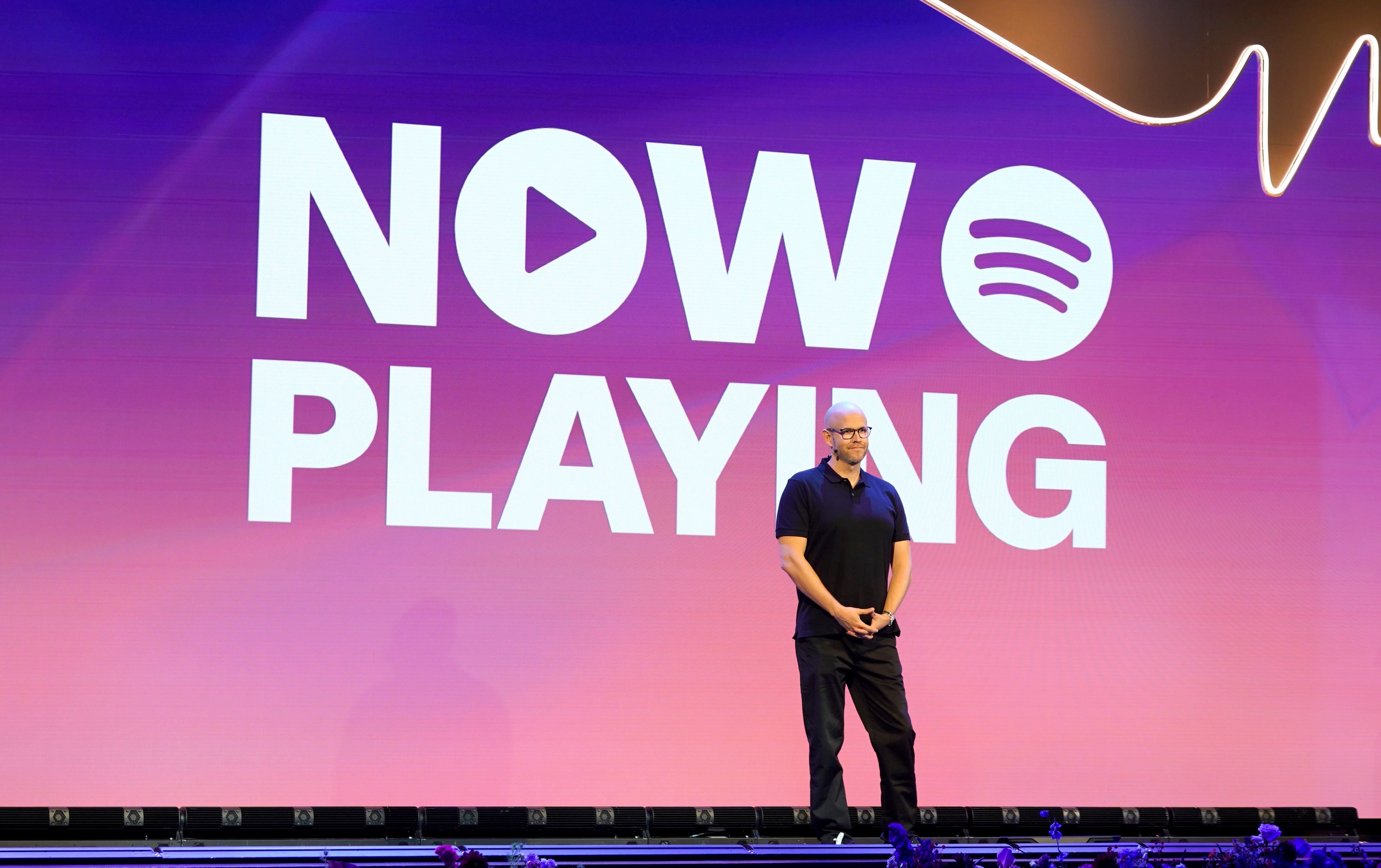Spotify is no longer a money-losing music app. So what is it now?
It is the app’s latest and biggest pivot, with podcasters and minor celebrities all involved. Andrew Griffin reports from behind the scenes of a tech company with a new vision to enhance the ‘Joe Rogan’ effect and take on YouTube


In a hall in Los Angeles, some of the world’s most famous talkers are gathered. But today, they’re here to listen. From Made in Chelsea’s Jamie Laing and Sophie Habboo – hosts of the podcast NewlyWeds – to wellness influencers such as Rich Roll and Steven Bartlett, all are being pitched on a vision of the future. That vision is video. Spotify is not the first major tech company to argue that video is the future for it and the world, and it is not even Spotify’s first foray into the format. But the company says this time is different.
This time, it means taking on YouTube; spending an awful lot more money; gathering some of the world’s most famous podcasters and other creators. And it might mean changing what Spotify actually is.
For years after its founding in 2006, Spotify was known for music. If it was known for anything else, it was disrupting the music industry: after years of losses from piracy, record labels finally found a new way of making songs pay.
But for the most part, that payment came from Spotify which, for almost all of its history, was losing money and as a result was viewed with pity.
Then, in the last few years, both things started to change. In 2015, it added podcasts but the new strategy didn’t really hit the headlines until 2020, when it signed an exclusive deal with Joe Rogan that prompted so much outrage that some of the world’s biggest musical artists left. Quietly, it added video to those podcasts, then added audiobooks too. Now it wants to take on YouTube as a rival home for videos.
At the same time, Spotify started to do something else: rapidly make lots of money. This week, it reported results showing it had an operating profit of €454m (£378m) in the last quarter, compared with €32m in the same period last year.
It’s clear that Spotify is now something else. But it is increasingly difficult to know exactly what Spotify is: if it is no longer just a music app, and no longer a kind of pitied technological exercise, what is it?
The company says that it is in a new era in which Spotify’s very nature is changing: it is now a kind of technical infrastructure through which creators of all kinds can make their work available and through which fans can enjoy it. And – at least according to its co-president and chief business officer Alex Norström – the world as well as Spotify is in a new age, too.
“We’re entering what I call the age of syndication,” he says, gesturing towards the idea that content will be spread across different platforms and in different ways. For his part, that means turning Spotify into the best place to make music, podcasts, audiobooks, and now video, available – but allowing those that make them to put them wherever they want.
Spotify hopes to make itself the place of choice by offering an improved experience largely built around not showing ads. Throughout its presentation to creators, it referenced the fact that competitors – such as YouTube – had been rapidly and dramatically increasing the number of ads shown to viewers, which has led to increased frustration.
One of Spotify’s core offers is to keep people coming back by giving subscribers “uninterrupted listening and watching of video podcasts”, says Norström, and that should also help convince creators because it will help make their content more enjoyable.
That wasn’t always Spotify’s plan. When it signed its deal with Rogan, it was about putting an end to syndication: until Spotify arrived, podcasts had been built around the open web and the idea that any episode was available in any functioning app.
That was “phase one” of Spotify’s push into podcasts, says Norström. It began in 2018 and was a very expensive and very successful way to encourage people to listen to podcasts on Spotify. “Back in 2018, we had a completely different hypothesis of what we would do with podcasts – we jumped head first, straight into it. And we learnt a ton.
“We spent so much money on it, and we had so many learnings from it, and so that’s what we’re kind of looking back on now and investing in to improve. So the whole notion of keeping podcasters exclusively to our platform is counter to the trend that I believe in – which is this age of syndication.
“We should be aligned with the podcasters’ mission, which is to be in as many places as possible. So keeping them exclusive to ourselves and our platform is misaligned with that.”
At the same time, that could also be useful to artists. During the same event in Los Angeles, Spotify’s head of editorial Sulinna Ong said that the company was looking to become a “one-stop shop” for artists, where they could not only release their records but also appear on podcasts to promote them.
Speaking with Meghan Trainor, who publishes both a podcast and songs, Ong noted that podcasts had become a central part of the promotional circuit. That allows for “cross-pollination listening”, where a person might find a song through a podcast or the other way around.
Moving into video turns Spotify into something it has never been before: a foreground rather than a background experience. Since the beginning, Spotify has been something that largely happens while you do something else, and people tend to feel good about it as a result. Now it is moving towards the experience offered by apps such as TikTok, which tend to hook users with an unending churn of scrolling that gives them no time to do anything else, and often leaves them unhappy at the end of it.
“There’s always room for candy, but we want to take towards the more nutritious end of things,” says Norström. “Spotify has always been about this. We’ve never been a passive experience.”
Users might spend an hour on Spotify and listen to 30-40 minutes of music, he suggests. “And then maybe you also listen to one or two episodes of a podcast that you’re following, and then maybe a chapter of your favourite audiobook. And so when you leave those 60 minutes with us, or 70 minutes, or whatever it is, you leave feeling good.
“Music is emotional; books and podcasts are emotional. You have to participate and invest. When you do that, you leave feeling better. So that’s the direction we’re moving and there’s obviously room for both nutrition and candy.”
Video sets the stakes even higher: there are a whole host of controversial and not necessarily nutritious options for podcasts, in a way that may not be true of music. How does Spotify plan to ensure that the content people find there is nourishing?
“Ultimately, it’s what our subscribers and users decide. They tend to devour things like knowledge podcasts, learning podcasts, and that’s the nature of longer-form stuff. It’s just more compatible with things that are more aspirational and more interesting and that require more of your attention. So that’s where we’re coming from, and that’s what it seems like people are asking for, so we’re going to give them more of that.”
The emotional connection to Spotify can go both ways, though. If people find that their home screen is being filled up with videos and podcasts they are not interested in, and their recommendations are less useful, then the push into video could harm other parts of the business.
As Norström says, people tend to like Spotify in part because it feels like something they own. “When you ask people why they like Spotify, they tend to say because it knows me, it’s my Spotify. We take that seriously.”





Join our commenting forum
Join thought-provoking conversations, follow other Independent readers and see their replies
Comments